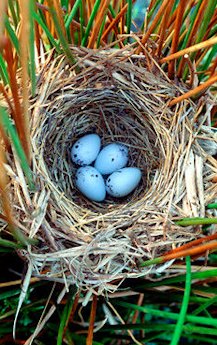
|
Nest Building by Birds Birds use as many materials to construct their nests as they find available in their environments. Birds commonly use twigs and grasses are common, with mud used to cement them. Some swallow nests use mud solely for nest building. The lining of birds nest are often composed of much softer and more elegant than the outer shell. Materials such as fine grasses, horsehair, thistledown, sheep's wool, spider webs, plant down, and feathers may grace the interiors. Tree Swallows especially love feathers to line their nest; nesting swallows will collect white chicken feathers offered near a nesting box. Many ducks and geese line their ground nests with warm, insulating layer of down plucked from the female's breast, and pull this layer over the eggs when they leave to feed or flee from a predator. Many shorebirds form a rather sparsely lined depression in the ground. Some sandpipers line the depression with grasses, golden-plovers use bits of lichen, and Killdeer use small pebbles, hardly a warm and comforting receptacle for their precious eggs. But the Common Murre, an abundant seabird that rests on bare rock of the cliff ledge. The pointed shape of the egg causes it roll in a small circle, helping to keep it from falling off the ledge. Most birds carry nest material to the nest site exactly as they carry their food: Birds of Prey carry it in their claws, and other species carry it in their bills. Many North American birds can be seen collecting grasses or fibers or carrying twigs in the spring, a sure sign of nesting activity and one of the easiest ways to locate a nest. Return to Bird Nesting Choices |
| Red-winged Blackbird Nest |